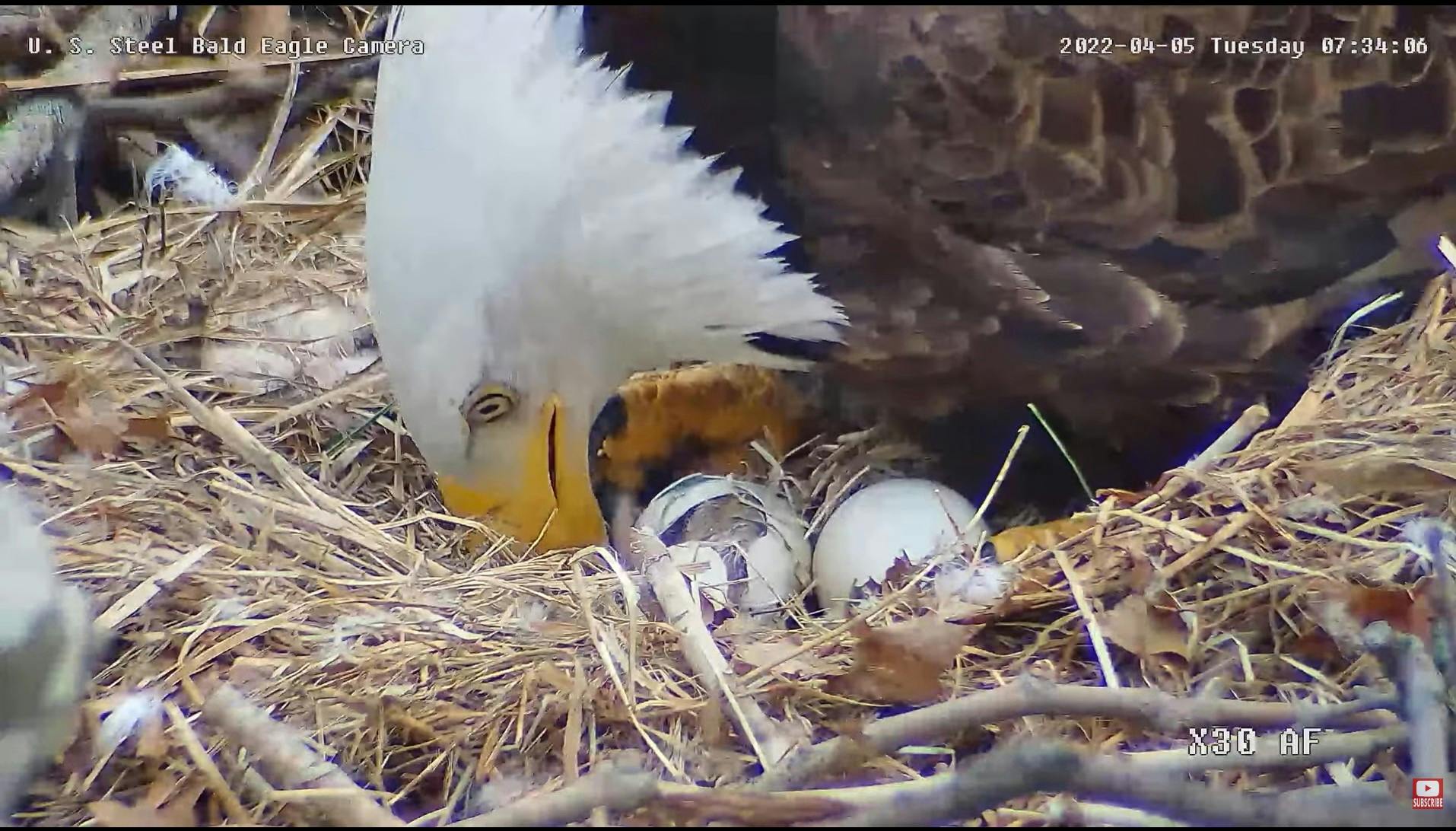Bald Eagle Egg Hatching Process
We expect to see the first eagle hatch at the Little Miami Conservancy Bald Eagle Nest located in Miami, Ohio at PixCams.com this nesting season. We expect a hatch to start around March 25th.
The hatching process of a bald eagle egg typically spans over a period of 35 to 38 days. It begins with the parent eagles carefully incubating the egg, taking turns to keep it warm and protected. Inside the egg, the embryo develops and grows, nourished by the yolk. As the incubation period progresses, the chick inside begins to peck at the shell using its egg tooth, a small projection on its beak specially designed for this purpose. Over time, the chick creates a series of cracks, called “pipping,” in the shell, until it can finally break free.
After the initial pipping, it typically takes approximately 24 to 48 hours for a bald eagle egg to fully hatch. The pip is the first visible crack in the eggshell made by the eaglet using its egg tooth. Following the pip, the eaglet continues to work its way around the circumference of the shell, creating a fracture line known as a “zipper.” This process, called zipping, enables the eaglet to gradually break free from the shell. Once the eaglet has completed zipping around the shell, it can push its way out, emerging fully from the egg.
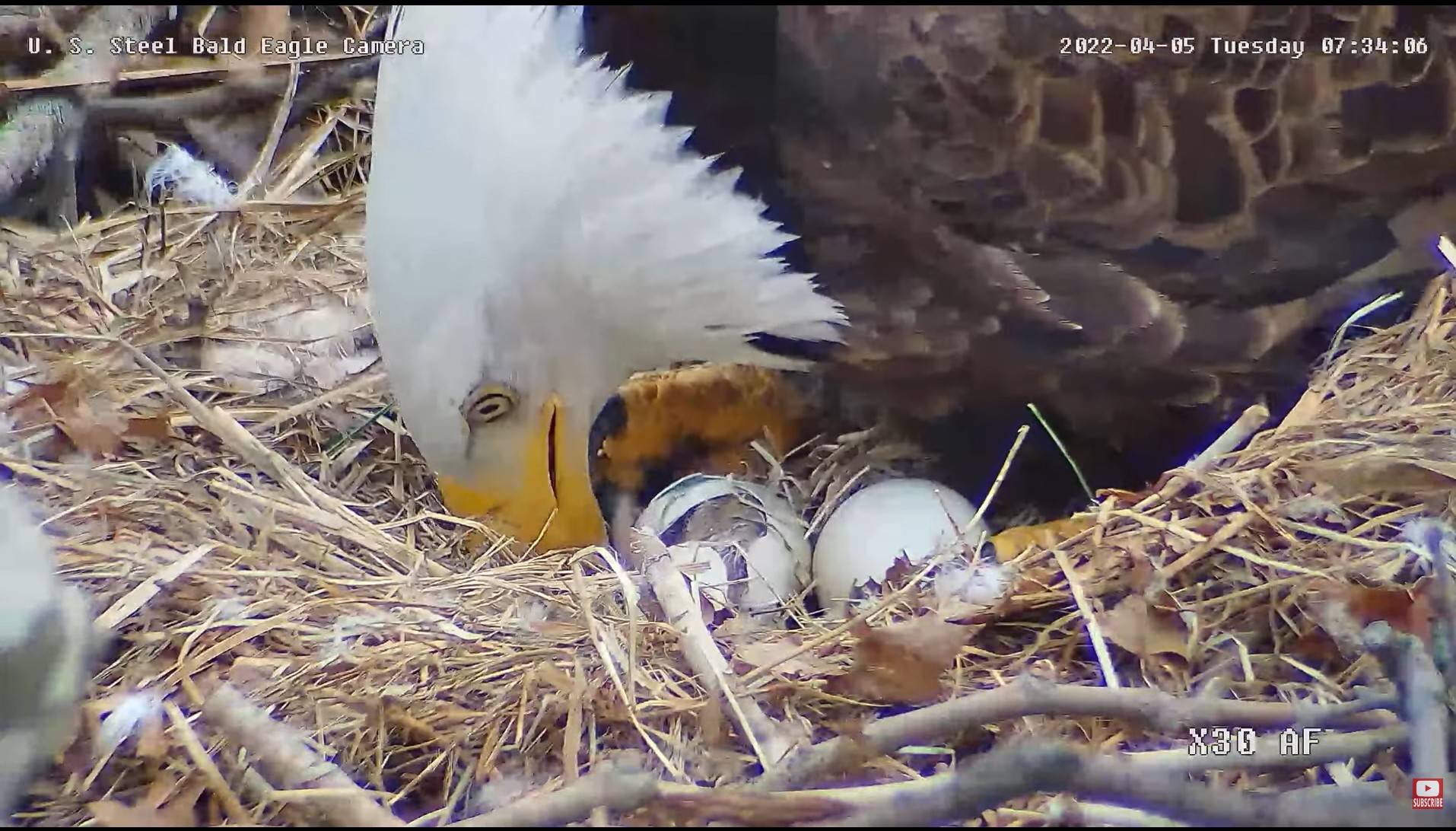 Eaglet hatching at United States Steel Corporation bald eagle nest on April 5, 2022 Eaglet hatching at United States Steel Corporation bald eagle nest on April 5, 2022 |
Do all the eggs hatch at once?
Eggs in a bald eagle nest may hatch at different times due to variations in the timing of fertilization, incubation, and individual development rates. Bald eagles typically lay eggs a few days apart, and each egg begins its incubation period when it’s laid. However, factors such as the temperature in the nest, the attentiveness of the parents, and the positioning of the eggs can influence the rate of development. Additionally, eggs in different locations within the nest may experience slight temperature variations, affecting their development rates. These natural variances in incubation conditions can lead to differences in hatching times. Furthermore, if food availability fluctuates, parents may adjust their incubation behaviors, potentially leading to differences in the timing of egg turning or warming. Ultimately, the staggered hatching can be beneficial for the survival of the offspring, as it reduces competition for food among siblings and ensures a more extended period of parental care for each individual eaglet.
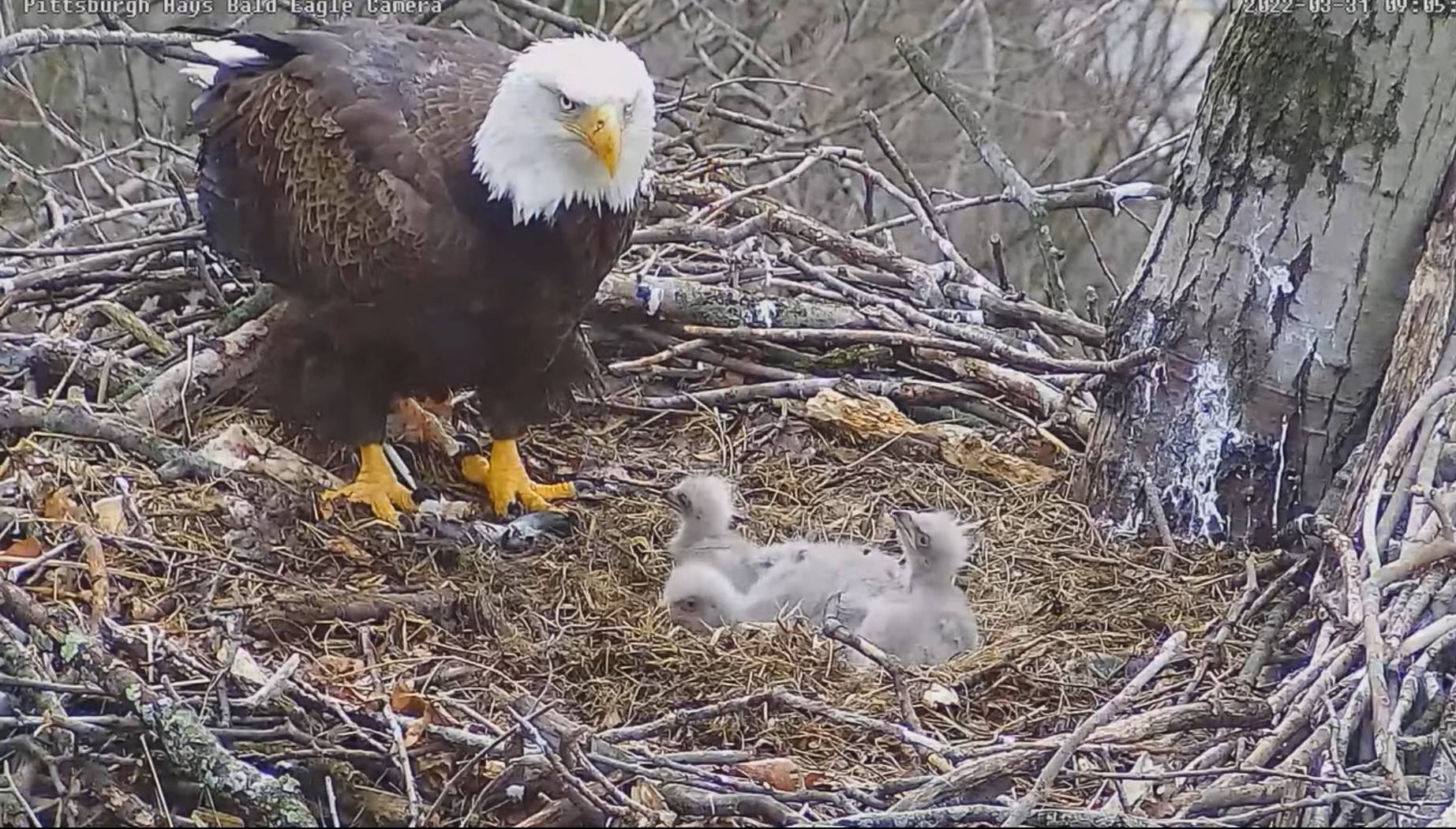 Three eagles of different sizes at Pittsburgh Hays bald eagle nest March 31, 2022 Three eagles of different sizes at Pittsburgh Hays bald eagle nest March 31, 2022 |
In a bald eagle nest, eaglets often exhibit differences in size due to variations in factors such as hatching order, parental care, and genetic predispositions. Eaglets hatching earlier typically have a head start in growth and development compared to their later-hatched siblings. They may receive more attention and food from the parents during the critical early stages, giving them an advantage in size and strength. Additionally, genetic variability can play a role, with some eaglets inheriting traits that promote faster growth rates. Furthermore, the availability of food resources can impact the growth of eaglets; those that receive more nourishment due to their positioning in the nest or their ability to compete more effectively for food may grow larger. Overall, the combination of hatching order, parental care dynamics, genetic factors, and food availability contributes to the observed differences in size among eaglets in a bald eagle nest.
Nesting failures
Although we all enjoy watching the nesting, hatching, and fledging process of the bald eagle nests not every egg in a nest hatches. Sometimes eggs fail to hatch. This is exactly what happened this year at the Pittsburgh Hays bald eagle nest on March 19th.
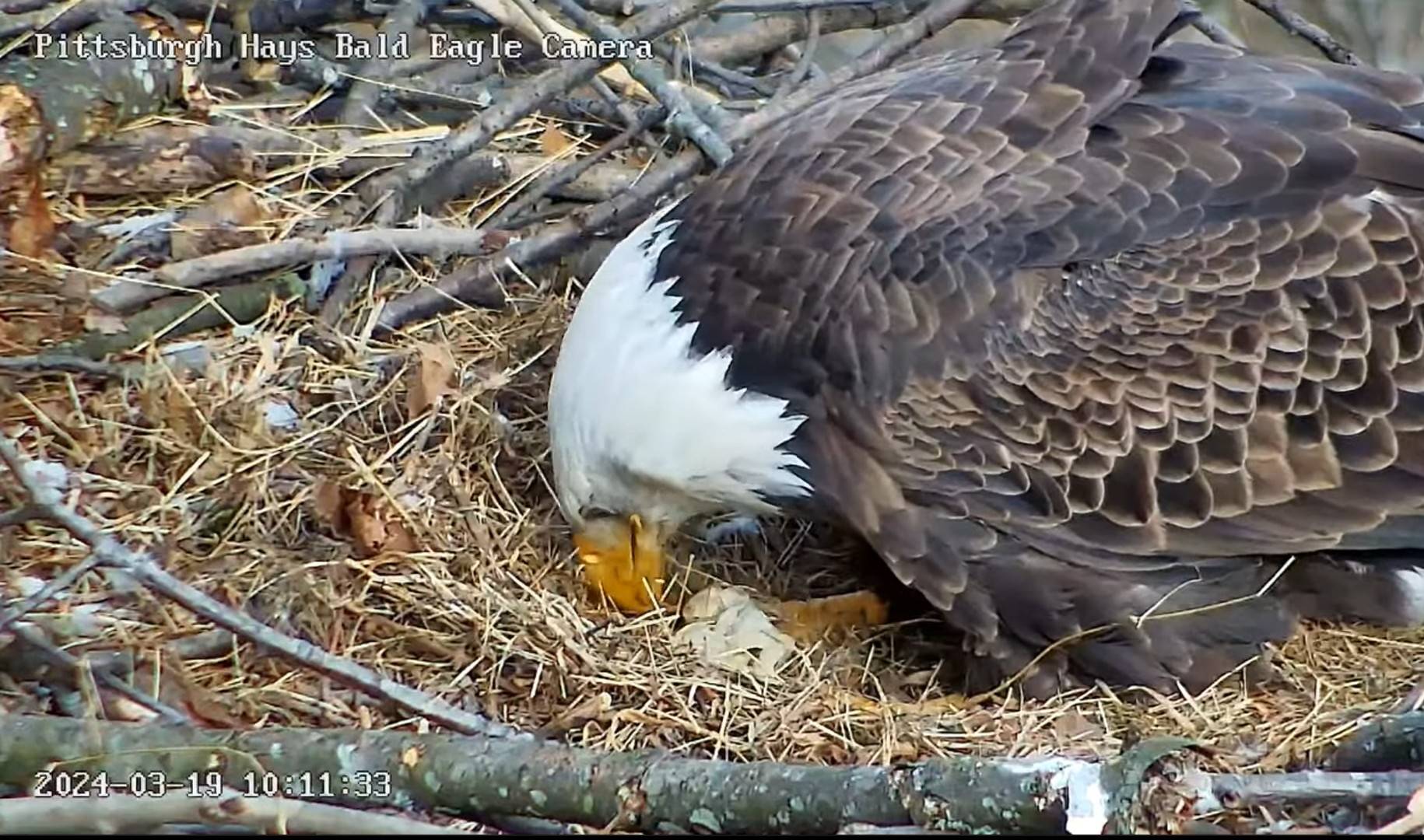 Collapsed egg at Pittsburgh Hays bald eagle nest March 19, 2024 Collapsed egg at Pittsburgh Hays bald eagle nest March 19, 2024 |
While we are not sure why the eagle egg failed at the Hays nest this year several factors can contribute to the failure of a bald eagle egg to hatch. One common cause is infertility, where the egg is not fertilized by the male during mating, rendering it unable to develop into an embryo. Physical damage to the eggshell, either during incubation or due to environmental factors, can prevent successful hatching by disrupting the embryo’s development or allowing bacteria to penetrate the egg. Inadequate incubation, whether due to the parent eagles’ inexperience, negligence, or disturbances in the nest, can also lead to egg failure, as proper temperature and humidity levels are crucial for embryo viability. Additionally, genetic abnormalities or developmental defects within the embryo itself can result in failed hatching. Environmental factors such as extreme weather conditions, pollution, or predation may also contribute to egg failure by compromising the health and viability of the embryo. Overall, the failure of a bald eagle egg to hatch can stem from a combination of biological, environmental, and behavioral factors that impact the egg’s development and viability.
Re-clutching after egg failure?
It’s relatively common for bald eagles to re-clutch, or lay a replacement clutch of eggs, after a nest failure. This behavior is especially prevalent in cases where the initial nesting attempt fails early in the breeding season, leaving the eagles with ample time to reattempt reproduction. Reasons for nest failure can vary widely, including predation, extreme weather events, infertility, or egg loss. Once a nest failure occurs, bald eagles may invest considerable effort in rebuilding or repairing their nest and subsequently lay a new clutch of eggs. However, the decision to re-clutch can also depend on factors such as the availability of suitable nesting sites, the eagles’ overall health and condition, and environmental conditions affecting food availability. Despite the common occurrence of re-clutching, it’s important to note that not all bald eagle pairs will attempt to re-nest after a failure, as individual circumstances and breeding strategies can vary among populations and individuals.
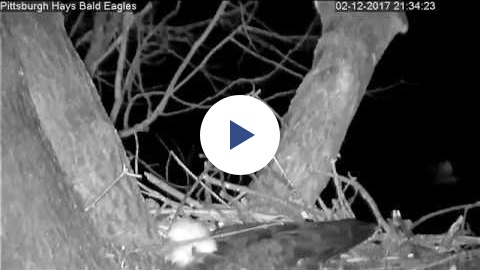
Hays nest tree blows down February 12, 2017
While is is highly unlikely we will see the Hays eagles re-clutch this nesting season since it is late in the nesting season we have witnessed a successful hatch after a nest failure in 2017. On February 12, 2017 the nest and tree blew down in a windstorm. The pair re-built a nest in a new location in only 4-days and laid the final egg of the clutch. This egg successfully hatched and the eagle successfully fledged that nesting season.
Come watch the LMC and USS nests!
This season there are three eggs at the Little Miami Conservancy Bald Eagle Nest with the first egg expected to start hatching around March 25th. There are two eggs at the United States Steel Corporation bald eagle nest with their first egg expected to hatch around April 5th.
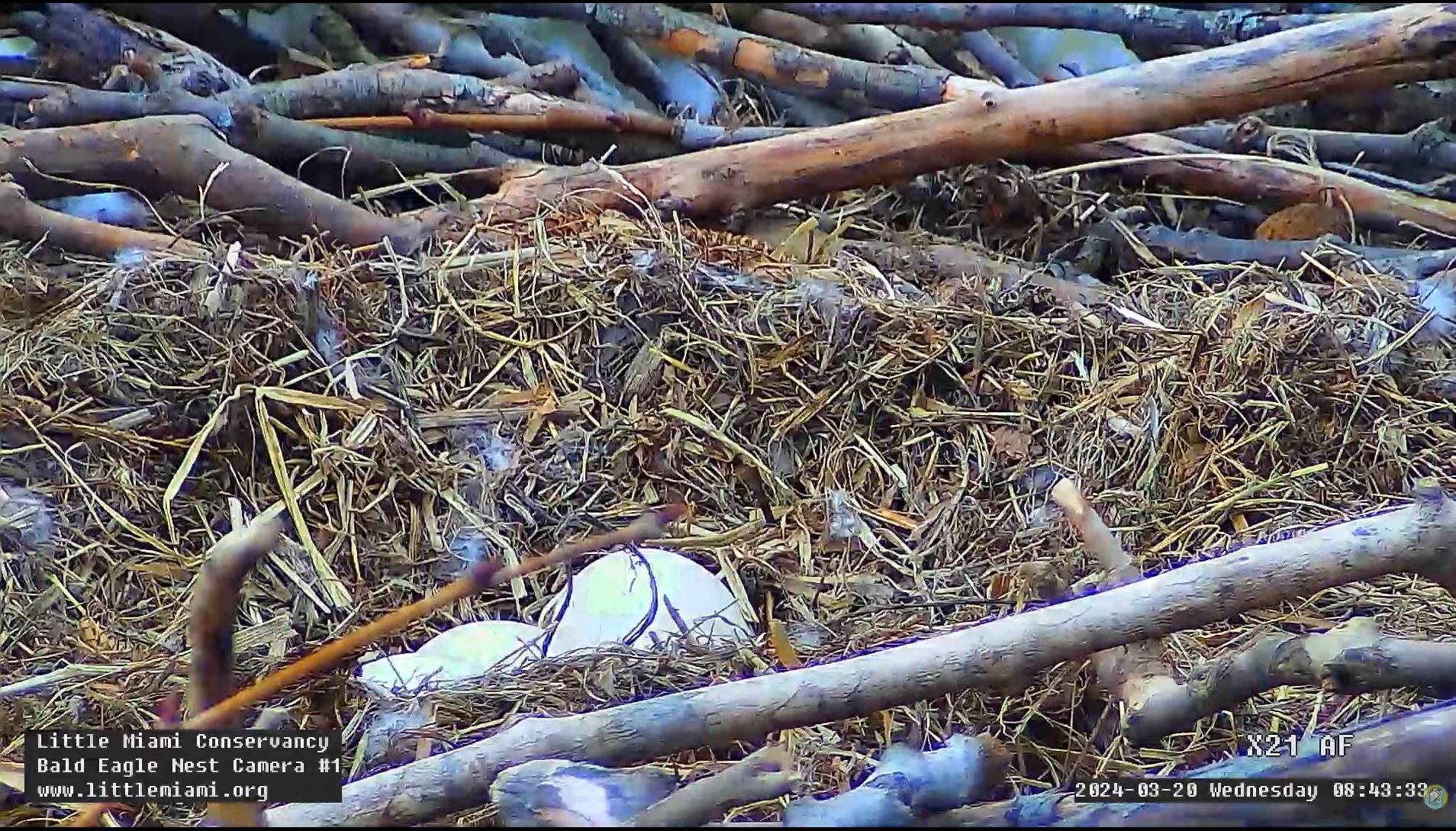 Three eggs at the Little Miami Conservancy Bald Eagle nest Three eggs at the Little Miami Conservancy Bald Eagle nest |
 Two egg at the United States Steel Corporation Bald Eagle nest Two egg at the United States Steel Corporation Bald Eagle nest |
How long until eaglets fledge the nest?
Bald eagles typically take about 10 to 12 weeks to grow from hatching until they fledge the nest. Initially, they hatch as small, helpless chicks covered in down feathers. Over the following weeks, they undergo rapid growth, with their down being gradually replaced by juvenile feathers. By around 10 to 12 weeks of age, they reach a size and strength sufficient to attempt their first flights, known as fledging. This period is crucial for their development as they strengthen their wings and muscles through exercise and practice flights within the safety of the nest before taking the bold leap into the sky. Once fledged, young eagles continue to refine their flying skills under the watchful eye of their parents until they become independent.
Before fledging, bald eagles engage in a behavior known as branching, which serves as a precursor to their first flights. This process typically begins a few weeks before fledging, as young eagles start to explore the surrounding area of the nest. They may hop or flap their wings while perched on nearby branches, gradually extending their range from the safety of the nest. Branching allows them to develop strength and coordination in their wings and legs, crucial skills for successful flight. During this time, they also gain confidence in their ability to maneuver and balance on branches, which prepares them for the eventual leap into flight. Branching is an essential part of the eaglet’s development, providing valuable practice and experience before they take the significant step of fledging the nest and embarking on their independent life.
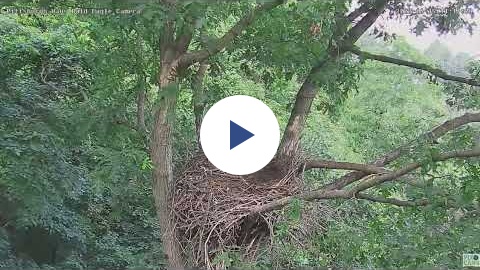
Hays Bald Eagle H18 Fledges 6/15/2022
Take the new Eaglet Quiz!
How much do YOU Know About Eaglets?
We all love to watch them grow, but how much do you know about these beloved babies? Test your knowledge with our two minute quiz and see how you stack up against other eagle enthusiasts!! Test your knowledge with our two minute quiz and see if you have what it takes to become an Eaglet Quiz Champion!
